
In the botanical classification of plants, Aeridinae Pfitzer is a subtribe of the tribe Vandeae whose representatives all have a monopodial growth habit and do not possess pseudobulbs.
Datuk Anthony L. Lamb, P.G.D.K. was a British botanist, born in British Ceylon who specialised in the flora of Sabah, East Malaysia, at the northern end of the island of Borneo.
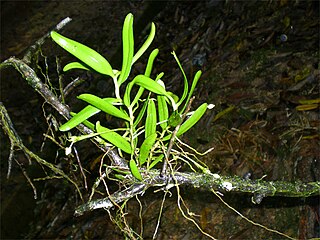
Thrixspermum trichoglottis is a monopodial orchid in the subfamily Epidendroideae. It is widespread across the eastern Himalayas, Yunnan, Indochina, the Andaman & Nicobar Islands, Malaysia and western Indonesia.

Robiquetia, commonly known as pouched orchids, is a genus of flowering plants from the orchid family, Orchidaceae. Plants in this genus are epiphytes with long, sometimes branched, fibrous stems, leathery leaves in two ranks and large numbers of small, densely crowded flowers on a pendulous flowering stem. There are about eighty species found from tropical and subtropical Asia to the Western Pacific.

Trichoglottis, commonly known as cherub orchids or 毛舌兰属 , is a genus of flowering plants in the family Orchidaceae. Orchids in this genus are epiphytic plants with thick roots, relatively thick, fibrous stems and many large, thick, leathery leaves arranged in two ranks. The flowers are usually small and yellowish with light brown or purple markings. The flowers have broad sepals, narrower petals and a labellum which has three lobes and is often hairy. There are about 85 species distributed from tropical and subtropical Asia to the north-western Pacific. Most species grow in rainforest.

Dendrobium sanguinolentum, the blood-stained dendrobium, is a species of flowering plant in the family Orchidaceae. It is native to Southeast Asia.
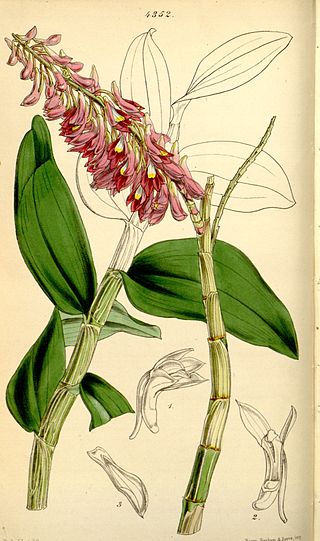
Dendrobium secundum, also known as the toothbrush orchid, is a species of flowering plant in the genus Dendrobium of the family Orchidaceae. The common name refers to the fact that all the flowers are on the same side of the stem, much like the bristles all on one side of a toothbrush.
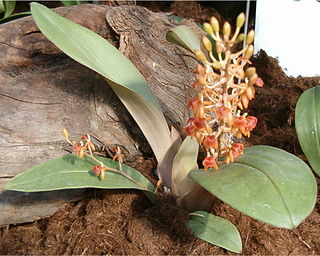
Liparis latifolia is a species of orchid native to Hainan, Thailand, Indonesia, Malaysia, the Philippines and New Guinea.
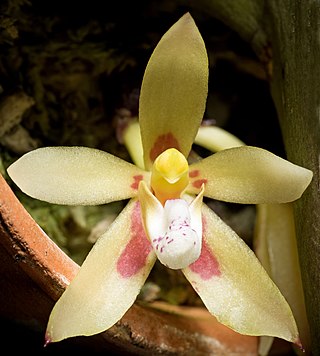
Brachypeza, commonly known as sage orchids, is a genus of flowering plants from the orchid family, Orchidaceae. Orchids in this genus have short stems with fleshy leaves and arching flowering stems with short-lived flowers. The sepals and petals are similar in size and shape and the labellum is pouch-like and suspended at the base of the flower. Sage orchids occur in tropical areas from Indochina to New Guinea.
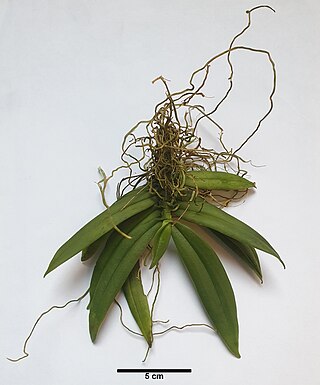
Grosourdya is a genus of flowering plants from the orchid family, Orchidaceae. As of May 2022, it contains 26 known species, native to Southeast Asia.
- Grosourdya appendiculata(Blume) Rchb.f. - widespread from Hainan to the Andaman Islands to the Philippines and Maluku
- Grosourdya bicornutaJ.J.Wood & A.L.Lamb - Sabah
- Grosourdya bigibba (Schltr.) Kocyan & Schuit.
- Grosourdya calliferaSeidenf. - Thailand
- Grosourdya ciliata (Ridl.) Kocyan & Schuit.
- Grosourdya decipiens (J.J.Sm.) Kocyan & Schuit.
- Grosourdya emarginata (Blume) Rchb.f.
- Grosourdya fasciculata (Carr) Kocyan & Schuit.
- Grosourdya incurvicalcar(J.J.Sm.) Garay - Java, Peninsular Malaysia, Sulawesi
- Grosourdya leytensis (Ames) Kocyan & Schuit.
- Grosourdya lobata Kocyan & Schuit.
- Grosourdya milneri P.O'Byrne, Gokusing & J.J.Wood
- Grosourdya mindanaensis (Ames) Kocyan & Schuit.
- Grosourdya minutiflora(Ridl.) Garay - Pahang
- Grosourdya minutissima P.T.Ong & P.O'Byrne
- Grosourdya multistrata P.O'Byrne, J.J.Verm. & S.M.L.Lee
- Grosourdya muscosa(Rolfe) Garay - Peninsular Malaysia, Thailand, Andaman Islands
- Grosourdya myosurus (Ridl.) Kocyan & Schuit.
- Grosourdya nitida (Seidenf.) Kocyan & Schuit.
- Grosourdya pulvinifera(Schltr.) Garay - Sabah, Sulawesi
- Grosourdya quinquelobata(Schltr.) Garay - Sulawesi
- Grosourdya reflexicalcarP.O'Byrne & J.J.Verm.
- Grosourdya tripercus(Ames) Garay - Leyte
- Grosourdya urunensisJ.J.Wood, C.L.Chan & A.L.Lamb - Sabah
- Grosourdya vietnamica (Aver.) Kumar & S.W.Gale
- Grosourdya zollingeri(Rchb.f.) Rchb.f. - Java, Maluku

Micropera, commonly known as dismal orchids or 小囊兰属 is a genus of about twenty species of flowering plants from the orchid family, Orchidaceae. Plants in this genus are large epiphytes with thick roots, long, fibrous stems, linear leaves and whitish or yellow, non-resupinate flowers. The sepals and petals are similar to each other and the labellum is shoe-shaped or sac-like and has three lobes. It is found from Tibet to tropical Asia and the western Pacific Ocean.
Pennilabium is a genus of flowering plants from the orchid family, Orchidaceae. It is native to Southeast Asia and the Himalayas.
- Pennilabium acuminatum(Ridl.) Holttum - Malaysia
- Pennilabium angraecoides(Schltr.) J.J.Sm. - Borneo
- Pennilabium angraecum(Ridl.) J.J.Sm. - Malaysia, Java
- Pennilabium armaniiP.O'Byrne, Phoon & P.T.Ong - Malaysia
- Pennilabium aurantiacumJ.J.Sm. - Java
- Pennilabium confusum(Ames) Garay - Philippines
- Pennilabium kidmancoxiiJ.J.Wood - Sabah
- Pennilabium lampongenseJ.J.Sm. - Sumatra
- Pennilabium longicauleJ.J.Sm. - Sumatra
- Pennilabium luzonense(Ames) Garay - Philippines
- Pennilabium najaP.O'Byrne - Sulawesi
- Pennilabium poringense(J.J.Wood & A.L.Lamb) Schuit. - Sabah
- Pennilabium proboscidcumA.S.Rao & J.Joseph - Arunachal Pradesh, Assam
- Pennilabium struthioCarr - Malaysia, Thailand
- Pennilabium yunnanenseS.C.Chen & Y.B.Luo - Yunnan, Thailand

Peristylus, sometimes commonly known as ogre orchids or bog orchids is a genus of flowering plants from the orchid family, Orchidaceae. It consists of over 100 known species found across much of eastern and southern Asia as well as in Australia and on many islands of the Indian and Pacific Oceans.

Pomatocalpa, commonly known as bladder orchids, or 鹿角兰属 , is a genus of about twenty five species from the orchid family, Orchidaceae. Plants in this genus are epiphytes or lithophytes with thick, leathery leaves and a large number of small flowers with a three-lobed labellum. There are about twenty five species found from tropical and subtropical Asia to the south-west Pacific.

Pteroceras is a genus of flowering plants from the orchid family, Orchidaceae. It is native to China, the Indian Subcontinent, and Southeast Asia.

Saccolabiopsis, commonly known as pitcher orchids, is a genus of flowering plants from the orchid family, Orchidaceae. Plants in this genus are small epiphytes with short, fibrous stems, smooth, thin roots, a few thin, oblong to lance-shaped leaves in two ranks and large numbers of small green flowers on an unbranched flowering stem. There are about fifteen species found from the eastern Himalayas to the south-west Pacific.
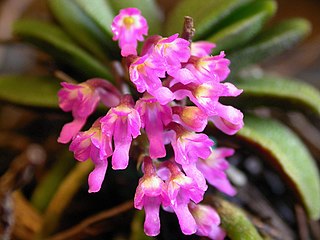
Schoenorchis, commonly known as flea orchids, or 匙唇兰属 in Chinese, is a genus of flowering plants from the orchid family, Orchidaceae. Plants in this genus are small epiphytes with thin roots, thin leafy stems with leaves in two ranks and tiny fragrant, almost tube-shaped flowers with a prominently spurred labellum. There are about twenty five species found from tropical and subtropical Asia to the Western Pacific.

Smitinandia is a genus of flowering plants from the orchid family, Orchidaceae. It contains three known species, native to Southeast Asia and the Himalayas.

Dendrobium uniflorum is a member of the family Orchidaceae. It is native to the Malesia and Southeast Asia regions, in Thailand, Vietnam, Malaysia, Philippines, Borneo, Sulawesi, Sumatra.

Trachoma, commonly known as spectral orchids, is a genus of flowering plants in the family Orchidaceae. Orchids in this genus are epiphytic plants with leafy stems, crowded, leathery leaves arranged in two ranks and a large number of relatively small, short-lived flowers that often open in successive clusters. The sepals and petals are free from and more or less similar to each other, except that the petals are often smaller. The labellum is rigidly fixed to the column and is more or less sac-shaped. There are about 17 species distributed from Assam to the Western Pacific Ocean. Most species grow in rainforests, often on emergent trees such as hoop pine.

















